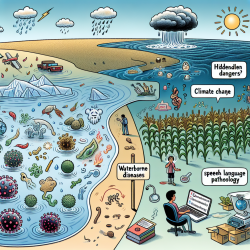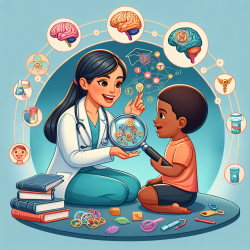Introduction
As practitioners dedicated to the well-being of children, understanding the broader environmental factors that can impact health is crucial. Recent research, "Climate variability and change in the United States: potential impacts on water- and foodborne diseases caused by microbiologic agents," provides compelling insights into how climate variability may influence the prevalence of water- and foodborne diseases. By integrating these findings into your practice, you can enhance your ability to create better outcomes for children.
The Connection Between Climate Change and Health
The study highlights that exposure to waterborne and foodborne pathogens can occur through various channels, including drinking water, seafood, and fresh produce. These exposures are often linked to fecal contamination, natural microbial hazards, or the disposal of wastewater. Climate factors such as rainfall and temperature play a significant role in the transport, dissemination, and survival of these microbial agents.
Federal and state laws offer some protection against these diseases, but as climate variability increases, so does the risk of contamination events. Understanding the transport processes and fate of microbial pollutants is essential for predicting risks associated with climate change.
Implications for Practitioners
For speech-language pathologists and other healthcare providers, this research underscores the importance of considering environmental factors when assessing and treating children. Here are some actionable steps practitioners can take:
- Stay Informed: Keep abreast of the latest research on climate change and its health impacts. This knowledge will help you understand potential environmental contributors to health issues in children.
- Collaborate with Other Professionals: Work with environmental scientists and public health officials to gain a comprehensive understanding of local climate-related health risks.
- Advocate for Better Infrastructure: Support initiatives aimed at improving public health infrastructure, such as better watershed protection and storm drainage systems, to mitigate the risks of contamination events.
- Educate Families: Inform families about the potential risks of climate-related health issues and provide guidance on how to minimize exposure to contaminated water and food.
Encouraging Further Research
The research suggests that while there are identified links between climate variability and microbial agents in water, these relationships require further quantification. As practitioners, encouraging further research in this area can lead to more precise risk assessments and better preventive measures.
Consider participating in or supporting studies that aim to explore these connections further. Advances in monitoring, such as molecular fingerprinting and satellite remote sensing, offer promising avenues for early-warning and prevention capabilities.
Conclusion
By understanding and addressing the potential impacts of climate change on health, practitioners can play a pivotal role in safeguarding the well-being of children. To read the original research paper, please follow this link: Climate variability and change in the United States: potential impacts on water- and foodborne diseases caused by microbiologic agents.










